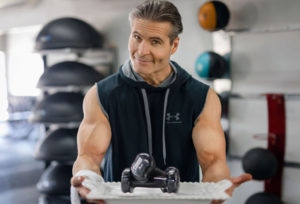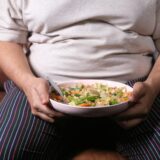The following is for informational purposes only. The reader is advised to always check with his or her doctor, nutritionist or other healthcare provider before starting any weight loss program or diet. The information below is a brief overview and contains the opinion of the author in some instances. In addition, always seek professional guidance if implementing any of the information below.
Why a Doctor’s Check-up Is Essential Before Starting a Personal Training Program
Many people dive into exercise or weight loss programs without consulting their doctor for a full physical exam and blood work. However, this step is crucial for anyone serious about improving their health, achieving fitness goals, or losing weight. A comprehensive health check can help determine if any underlying medical conditions are preventing progress and ensure you’re starting your fitness journey on an “even playing field.”
Is Your Health Holding You Back from Reaching Your Fitness Goals?
It’s incredibly frustrating to put in months of effort at the gym and see little to no progress. The truth is, underlying health issues—such as thyroid imbalances, hormonal fluctuations, or adrenal dysfunction—could be sabotaging your fitness efforts. Worse, autoimmune disorders or other chronic health conditions could also be at play.
How Seeing a Doctor Can Improve Your Results
Many clients I’ve worked with initially resisted seeing a doctor before starting their fitness program. After months of working hard with minimal results, they finally decided to get checked out and discovered issues like hypothyroidism, low testosterone, or elevated cortisol levels caused by stress. These conditions can significantly impact weight loss, energy levels, and muscle development. Had they known this earlier, their training efforts would have been much more effective.
The Importance of Blood Work and Physical Exams for Fitness Success
Before committing to a personal training program or weight loss plan, I highly recommend seeing your doctor for a full physical exam and blood work. A clean bill of health ensures that you’re physically prepared to take on the demands of exercise, and it helps identify any issues that might need medical attention. Identifying and addressing health problems early can help you avoid frustration down the road and set you up for long-term success.
Why Knowing Your “Normal” Is Important
It’s essential to understand what’s “normal” for your body, not just the general population. Lab reference ranges are often wide, and what’s normal for one person may not be optimal for another. For example, even if your thyroid or testosterone levels fall within the “normal” range, you might still experience symptoms that affect your workout progress. If you’re experiencing fatigue, weight gain, or difficulty building muscle, talk to your doctor about potential treatments or interventions.
A thorough health check before beginning a personal training program can save you time, frustration, and unnecessary setbacks. By addressing any health issues upfront, you can ensure that your efforts in the gym are working toward the best possible results. Don’t let hidden health problems stand in the way of your fitness goals—schedule a doctor’s visit and start your fitness journey with a clean bill of health.
Recommended Health Tests for Fitness Enthusiasts
Here are the key tests I suggest for anyone starting a personal training or fitness program. Of course, discuss these with your doctor to determine which ones are right for you:
- Thyroid Function Tests: Check for imbalances like hypothyroidism or hyperthyroidism, which can affect metabolism and energy levels.
- Hormone Levels: Testosterone, estrogen, and progesterone can impact muscle growth, fat loss, and overall fitness performance.
- Adrenal Function: Elevated cortisol levels from chronic stress can hinder weight loss and cause fatigue.
- Comprehensive Blood Panel: Assess overall health and identify potential deficiencies that could affect energy, recovery, and strength.
Food Allergies, Sensitivities, and Histamine Intolerance: How They Impact Your Fitness Progress
As we work towards staying fit and healthy, one of the most important aspects of maintaining overall wellness is reducing inflammation in the body. A major contributor to chronic inflammation is food allergies and food sensitivities. While severe food allergies—such as those to peanuts—are easy to identify due to symptoms like hives or difficulty breathing, many people suffer from food sensitivities that are less obvious but can still significantly impact health and fitness.
If you’re experiencing symptoms like a bloated stomach, joint pain, headaches, fatigue, or even heart arrhythmias, it’s possible you could have a food sensitivity or histamine intolerance that’s affecting your progress in the gym or hindering your ability to lose weight.
How Food Sensitivities Can Undermine Your Fitness Goals
Food sensitivities often go unnoticed because they don’t always show up in standard allergy tests. These delayed reactions can lead to a slow but constant inflammatory response that disrupts your immune system and metabolism, making it harder to achieve your fitness goals. If you’ve been feeling sluggish or experiencing unexplained symptoms that won’t go away, it’s time to consider that your diet might be at the root of the problem.
Common signs of food sensitivities include:
- Bloating or digestive discomfort
- Joint pain or muscle soreness
- Chronic fatigue or lethargy
- Headaches or migraines
- Skin irritation or rashes
- Irregular menstrual cycles
- Swelling or water retention
If you suspect you may have a food sensitivity, here are a few methods to identify potential triggers:
Steps to Identify Food Sensitivities:
- Elimination Diet: One of the simplest and most effective ways to uncover food sensitivities is by following an elimination diet. This process involves cutting out common allergens or inflammatory foods (such as dairy, gluten, or high-histamine foods) for at least 3-4 weeks. After this period, you can slowly reintroduce each food one by one to see if symptoms reappear. This method helps pinpoint exactly what foods may be causing discomfort or hindering your progress.
- Applied Kinesiology: This technique, also known as muscle testing, is used by some practitioners to identify food sensitivities by assessing your body’s reaction to different substances. While not a definitive diagnosis, it can provide helpful insights when used in combination with other tests.
- Consult a Specialist: For a more thorough approach, you may want to consult a functional medicine doctor, naturopath, or osteopathic physician. These professionals often conduct saliva tests, blood tests, or other diagnostic procedures to determine food sensitivities, intolerances, or allergies. Books like Dr. William R. Walsh’s “A Complete Guide to Understanding Your Food Allergies” can also provide helpful information on this topic.
More on Histamine Intolerance and Its Impact on Fitness
A Histamine is a neurotransmitter involved in communication within the brain and is also present in stomach acid. For some people, the body struggles to break down histamine from foods like aged cheese, fermented products, and alcohol, combined with the histamine in their stomach acid. This can lead to a range of symptoms, including headaches, fatigue, digestive issues, and even skin irritation.
If you suspect histamine intolerance might be affecting your workouts or general health, consult your doctor for testing or advice. Managing histamine levels can help improve your fitness progress and overall well-being.
Eating for Fitness Success: Nutrition Tips for a Stronger, Leaner Body
Proper nutrition is one of the most important factors in fitness success. A balanced diet not only supports muscle growth and weight loss but also helps slow down the aging process and reduces the risk of disease. Here are some key nutrition strategies that can help you achieve your fitness goals and age gracefully:
- Total Calories: Eat for Fat Loss, Not Muscle Loss
When working towards weight loss, aim to eat about 10% fewer calories than your body’s maintenance level. This ensures that the weight loss comes primarily from fat, not muscle. To calculate your maintenance calories, multiply your body weight by 13 if you’re active or 11 if you’re less active. Adjust this number based on your age, lean body mass, and activity level and age can be another factor to consider.
A helpful strategy is to vary your daily calorie intake—some days eat a bit more, other days eat less—while aiming for a weekly calorie goal. This keeps your metabolism from slowing down and prevents your body from adapting to a constant caloric intake.
- Protein: Fuel Your Muscles and Keep Hunger at Bay
Protein is an essential nutrient for building and maintaining lean muscle mass. Be sure to include a source of protein in every meal to prevent muscle breakdown and promote recovery. Protein also helps you feel fuller for longer, which can prevent overeating and aid in weight loss. Aim for about 1.6 – 1.8 grams of protein per kilogram of body weight, especially if you’re following a resistance training program.
- Meal Timing: Keep Your Metabolism Active
Eating smaller meals every 3-4 hours throughout the day helps keep your metabolism running high and supports muscle repair and growth. Avoid going longer than 4 hours without eating to prevent your body from entering a catabolic state (where muscle tissue is broken down for energy). Aim for 4-5 meals per day, with the largest meals earlier in the day or before your busiest activities.
Fuel Your Fitness with a Personalized Approach
Whether you’re trying to lose weight, build muscle, or simply improve your overall health, your nutrition plan plays a huge role in your success. If you suspect food allergies or sensitivities are affecting your progress, consult with a doctor or nutritionist to get to the root cause. A tailored diet plan, along with regular exercise and proper recovery, will help you achieve your fitness goals and maintain a youthful, energized body for years to come.
Pre and Post-Workout Meals: Fueling Your Fitness Success
When it comes to achieving your fitness goals, pre and post-workout meals are some of the most important meals to focus on. These meals are a key opportunity for nutrient absorption, helping your body recover and rebuild muscle tissue after exercise. This time frame is often referred to as the “window of opportunity,” during which your body is highly receptive to nutrients like proteins, fats, and carbohydrates. To maximize your workout recovery and support muscle growth, it’s important to carefully select the right foods for these critical times.
Why Post-Workout Nutrition Matters for Muscle Recovery
After an intense workout, your body needs the right nutrients to repair and rebuild muscle fibers that were broken down during exercise. Protein is especially crucial at this time. It’s best to consume a fast-digesting protein, such as whey protein, to quickly deliver amino acids to your muscles and support muscle recovery. A whey protein shake right after your workout is an excellent option for this purpose. This fast-absorbing protein can help accelerate the recovery process and prevent muscle breakdown, allowing you to bounce back stronger.
Interestingly, carbohydrates also play a key role in post-workout nutrition. Carbs help replenish muscle glycogen stores, which are depleted during exercise. This is where the glycemic index (GI) of carbs becomes important. Post-workout, your body is in a prime state to absorb simple sugars and carbs, making them beneficial for quick glycogen recovery.
However, excess sugar consumed outside of the workout window can lead to fat storage. This is why it’s crucial to separate carb and protein intake at different times during the post-workout period. After eating carbohydrates, wait about 30 minutes before consuming protein to allow proper digestion. This approach helps optimize the body’s ability to process both nutrients efficiently.
Food Quality: Choosing the Right Carbs for Recovery
When selecting carbohydrates for your post-workout meal, focus on complex carbs rather than simple sugars. The glycemic index (GI) helps distinguish between these types of carbs:
- Low GI (55 or less) = Complex carbohydrates (better for stable energy release)
- Medium GI (56-69) = Moderate sugar release
- High GI (70 or more) = Simple sugars (fast sugar release, often leading to fat storage if consumed regularly outside workouts)
To maximize your fat loss and avoid insulin resistance, choose complex carbs like whole grains, sweet potatoes, quinoa, and vegetables. These carbs have a low GI, meaning they release energy slowly and do not spike insulin in the same way simple sugars do. Over time, consuming too much simple sugar can lead to insulin resistance, which can sabotage weight loss efforts and lead to diabetes.
The glycemic load is also an important factor to consider. It indicates how much sugar is in a serving of food and is used alongside the GI to understand how a food will affect your blood sugar. Aim for foods with a low glycemic load (1-10) to keep your insulin levels stable and support fat-burning and muscle recovery.
What Are Net Carbs?
When tracking your carbohydrate intake, net carbs are often calculated by subtracting fiber content from the total grams of carbs. The reasoning behind this is that fiber does not significantly affect blood sugar levels. However, it’s important to note that soluble fiber can still influence blood sugar levels to some extent, so be mindful of the type of fiber you’re consuming. For optimal blood sugar control and fat loss, aim to consume more insoluble fiber (found in vegetables and whole grains) and less soluble fiber.
Sugar Alcohols and Artificial Sweeteners: Proceed with Caution
Many sugar alcohols (like erythritol, sorbitol, and xylitol) are often added to low-calorie or “sugar-free” products. While these sweeteners have fewer calories than sugar, they can cause digestive issues like gas, bloating, and cramping. Additionally, sugar alcohols can increase urination, leading to a loss of vital minerals like calcium, magnesium, and potassium. Magnesium, in particular, is essential for muscle relaxation, and low levels can contribute to muscle cramps and joint stiffness.
If you want to avoid the digestive upset and mineral depletion caused by sugar alcohols, focus on whole, unprocessed foods and limit consumption of artificially sweetened products.
Best Foods for Pre and Post-Workout Nutrition
For both pre and post-workout meals, food quality is key. Here’s a breakdown of what to eat to fuel your body properly:
Pre-Workout Meals:
- Focus on complex carbs (sweet potatoes, brown rice, oats) for sustained energy during your workout.
- Include a small amount of healthy fats (avocados, nuts, seeds) for longer-lasting energy.
- Avoid sugary snacks or simple carbs right before exercise, as they can cause a spike and crash in energy.
Post-Workout Meals:
- Carbs: Choose complex carbs (whole grains, quinoa, sweet potatoes) to replenish glycogen stores.
- Protein: Consume fast-digesting protein (whey protein or lean meats) to repair and rebuild muscles.
- Healthy Fats: Include healthy fats (olive oil, avocado, fatty fish like salmon) to support overall recovery and reduce inflammation.
Food Quality Guidelines for Optimal Health and Fitness
To support muscle growth, fat loss, and overall health, follow these guidelines for food quality:
- Avoid bread and white flour: Opt for whole-grain alternatives like Ezekiel bread, pumpernickel, or sourdough.
- Limit fried foods: Choose healthier cooking methods like grilling, baking, or steaming.
- Choose healthy fats: Incorporate avocados, almonds, flaxseeds, hemp seeds, and fatty fish like salmon or sardines.
- Eliminate vegetable oils and seed oils: Swap out vegetable oils for olive oil, avocado oil, or coconut oil.
A Note on Olive Oil:
While olive oil is an excellent choice for salads and cold dishes, avoid cooking with it at high temperatures due to its low smoke point. When olive oil begins to smoke, it can break down and produce harmful compounds. For high-heat cooking, choose oils with higher smoke points, such as avocado oil or coconut oil.
Fuel Your Fitness Journey with Smart Nutrition Choices
By optimizing your pre and post-workout nutrition, you can enhance your muscle recovery, boost energy levels, and support fat loss. Choosing the right foods with the right timing is crucial for maximizing your workouts and ensuring long-term fitness success. Remember to prioritize complex carbohydrates, healthy fats, and high-quality proteins to build a strong, lean body and improve overall performance.
Healthy Eating for Optimal Performance: Nutrition Tips for Personal Training Success
When it comes to achieving fitness goals, nutrition plays a critical role. Whether you’re training for muscle gain, weight loss, or overall health, what you eat can make a huge impact on your performance and recovery. Let’s dive into some essential nutrition tips that can help optimize your workouts, support recovery, and enhance your overall well-being.
Avoid Trans Fats and Processed Foods for Better Health
Trans fats are commonly found in processed foods, fast food, and many packaged snacks. They’re created when oils are hydrogenated, and when you see “hydrogenated” or “partially hydrogenated” oils on ingredient lists, it’s a red flag. Trans fats not only raise LDL cholesterol (the “bad” cholesterol) but also increase the risk of heart disease.
Vegetable oils, commonly used in cooking, can also be problematic because they can damage the lipid molecules in our cells, making it more difficult for the body to recognize and use them. Sugar and high fructose corn syrup (HFCS) can have similar negative effects on metabolism. HFCS, often used in sugary drinks and processed foods, bypasses digestion and is directly processed by the liver into fat, contributing to fatty liver disease and insulin resistance, which can lead to diabetes.
To optimize your health and fitness goals, it’s important to avoid trans fats, limit processed sugars, and choose healthier fats like olive oil, avocado oil, and coconut oil.
Choose a Variety of Whole Foods to Fuel Your Body
For muscle growth, recovery, and overall health, it’s essential to eat a variety of high-quality foods:
- Proteins: Incorporate lean meats like turkey, chicken, and fish, as well as plant-based proteins such as lentils and peas. Eggs are also a great source of high-quality protein.
- Vegetables: Fill your plate with green vegetables like spinach, kale, and broccoli, as well as colorful vegetables for a wider array of nutrients. Root vegetables like carrots, sweet potatoes, and beets are higher in calories, so enjoy them in moderation if you’re focusing on fat loss.
- Grass-fed Meat and Dairy: Opt for grass-fed and antibiotic-free meat and dairy. Greek yogurt is a personal favorite for its protein content and probiotics. If you’re lactose intolerant, try almond milk or coconut milk as dairy alternatives.
- Whole Grains: Avoid refined grains like white rice and white flour. Instead, choose whole grains such as brown rice, quinoa, and whole wheat pasta. For a more nutritious option, sprouted grains like sprouted brown rice and sprouted wheat are a great choice. Sprouting grains can make them more digestible and nutrient-dense by breaking down the lectin in the outer shell. However, sprouting can be tricky, so using a pressure cooker for cooking sprouted grains is recommended for best results.
Understand the Impact of Sodium and Salt on Your Health
When it comes to salt, many people consume far more than needed, especially from processed foods. Aim to limit your sodium intake to around 1,500 mg per day. Excess sodium can lead to high blood pressure and other cardiovascular issues.
Instead of regular table salt, try using Himalayan pink salt, which contains 84 essential minerals that promote better muscle function, blood sugar regulation, and cellular health. It can also help prevent muscle cramps and spasms. Be mindful of your sodium intake, and always check food labels to ensure you’re not overdoing it.
Hydration: How Water Supports Fat Loss and Muscle Recovery
Hydration is key to both muscle recovery and fat loss. Aim to drink about 1 ounce of water per kilogram of body weight. For example, if you weigh 180 lbs (82 kg), you should aim for approximately 82 ounces of water a day. Proper hydration keeps your kidneys and liver functioning well and helps your body burn fat for energy instead of relying on carbs.
It’s also important to note that drinking too much water during meals can dilute your digestive enzymes. Try drinking water about 10 minutes before meals or 45 minutes after eating for optimal digestion. If you’re an athlete or someone who sweats a lot, consider drinking a 7% carbohydrate solution (around 65-70 calories per 8 oz) to help with hydration and nutrient absorption during intense workouts.
The Role of Fiber in a Healthy Diet
Fiber is essential for digestive health and overall well-being. There are two main types of fiber:
- Soluble fiber: Found in foods like oats, legumes, fruits, and vegetables, soluble fiber helps lower blood cholesterol levels and slows the absorption of sugars, keeping blood sugar levels stable.
- Insoluble fiber: Found in wheat, vegetables, and whole grains, insoluble fiber helps move food through your digestive system and supports healthy bowel movements.
Most adults should aim for 21-40 grams of fiber per day to keep the digestive system running smoothly and to support fat loss. Eating a variety of fiber-rich foods, like green leafy vegetables, whole grains, and legumes, will ensure you’re getting both types of fiber for maximum health benefits.
Snacking: Healthy Options for Muscle Maintenance
If you find yourself hungry before bed or need a snack to keep your metabolism active, opt for lean protein over carbohydrates. Turkey is an excellent choice because it contains L-tryptophan, an amino acid that promotes better sleep. A small portion (2-3 oz) of turkey before bed can help minimize muscle breakdown and keep hunger at bay overnight.
For those on a calorie-restricted diet or training to achieve low body fat, it’s best to avoid eating carbs (other than low-calorie veggies) in the evening. This ensures your body stays in fat-burning mode while you sleep.
Vitamins & Supplements: Should You Take Them?
If you’re healthy and under 40, a well-balanced diet should provide all the nutrients you need. However, certain supplements can be beneficial if you’re training intensively or have specific nutritional needs:
- Omega-3s (DHA/EPA): Supports heart health, reduces inflammation, and aids in mental clarity.
- Vitamin D3: Essential for bone health and immune function.
- Magnesium: Helps relax muscles, reduces cramping, and supports overall muscle function.
- Probiotics: Promotes gut health, which is crucial for digestion, immune function, and nutrient absorption.
Before starting any supplement regimen, always check with your healthcare provider, especially if you have any existing conditions or are undergoing surgery. Supplements can interfere with medications or other health conditions, so it’s important to get professional guidance.
Conclusion: Healthy Eating for Personal Training Success
By prioritizing whole, nutrient-dense foods and staying mindful of your macronutrients and hydration, you can optimize your training results and achieve your fitness goals. Whether you’re looking to build muscle, lose fat, or simply stay healthy, proper nutrition is the key to success. Make informed food choices, maintain balanced eating habits, and complement your diet with appropriate supplementation if needed.
healthy eating for optimal performance
Ready to enhance your training programs with grip strength exercises? Contact us today to schedule a consultation with John Turk, San Diego’s top personal trainer for aging professionals wanting to get their body back. Whatever your fitness goals are, we’ll create a customized plan that works for you.
Call 858-877-1370
Visit us at www.PersonalTrainerSanDiego.com to Get Started










